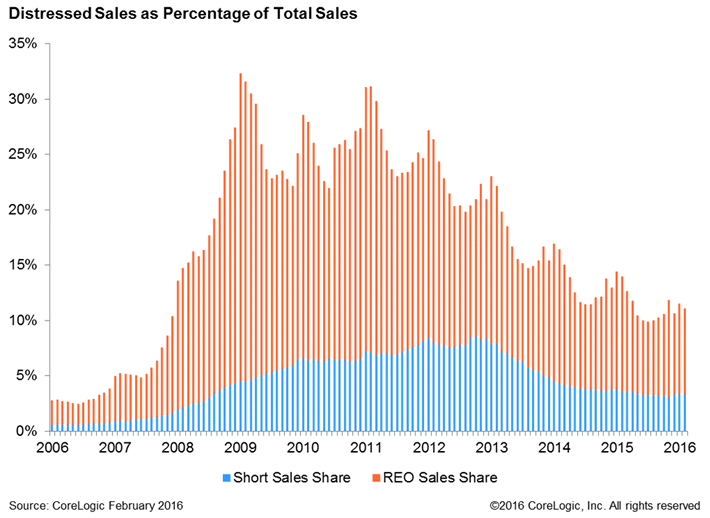Distressed properties represented a smaller share of all home sales once again in February. CoreLogic reports that 11.1 percent of closed sales during the month were properties either sold out of lender owned real estate (REO) or as short sales. This is down 2.9 percentage points from the total of distressed sales a year earlier and 0.4 points less than in January 2016.
REO sales accounted for 7.8 percent of home sales and short sales for 3.3 percent. REO sales were the lowest for any February since 2007. The short sales share fell below 4 percent two years ago and has remained in the 3 to 4 percent range since then.

There were only nine states in which the share of distressed sales did not decline from a year earlier and CoreLogic noted that, despite the current downturn in the energy sector, none of the large oil producing states were among them. Maryland had the largest share of distressed sales of any state at 19.9 percent followed by Connecticut (19.1 percent), Michigan (18 percent), Florida (17.5 percent) and Illinois (17.1 percent). Among the large oil states, Texas saw a year-over-year decline in its distressed sales share of 1.3 percentage point, Oklahoma was down a half point and North Dakota saw a 0.2 percentage point decrease.
Nevada had the largest 12-month decline in its distressed sales share, a 4.8 percentage point drop. California had the largest improvement of any state from its peak distressed sales share, falling 59.8 percentage points from its January 2009 peak of 67.4 percent.
Only three of the largest 25 core-based statistical areas (CBSAs) had year-over-year increases in their distressed sales share: Nassau & Suffolk Counties (NY) rose 0.6 percentage points as did Baltimore, and the Washington DC area was up 0.1 point. Orlando-Kissimmee-Sanford, Fla. had the largest year-over-year drop in its distressed sales share, declining from 24.3 percent in February 2015 to 19.1 percent in February 2016.
At its peak in January 2009, distressed sales totaled 32.4 percent of all sales, with REO sales representing a 27.9 percent share. While distressed sales play an important role in clearing the housing market of foreclosed properties, they sell at a discount to non-distressed sales, and when the share of distressed sales is high, it can pull down the prices of non-distressed sales. By comparison, the pre-crisis share of distressed sales was traditionally about 2 percent. If the current year-over-year decrease in the distressed sales share continues, it will reach that "normal" 2-percent mark in mid-2018.







